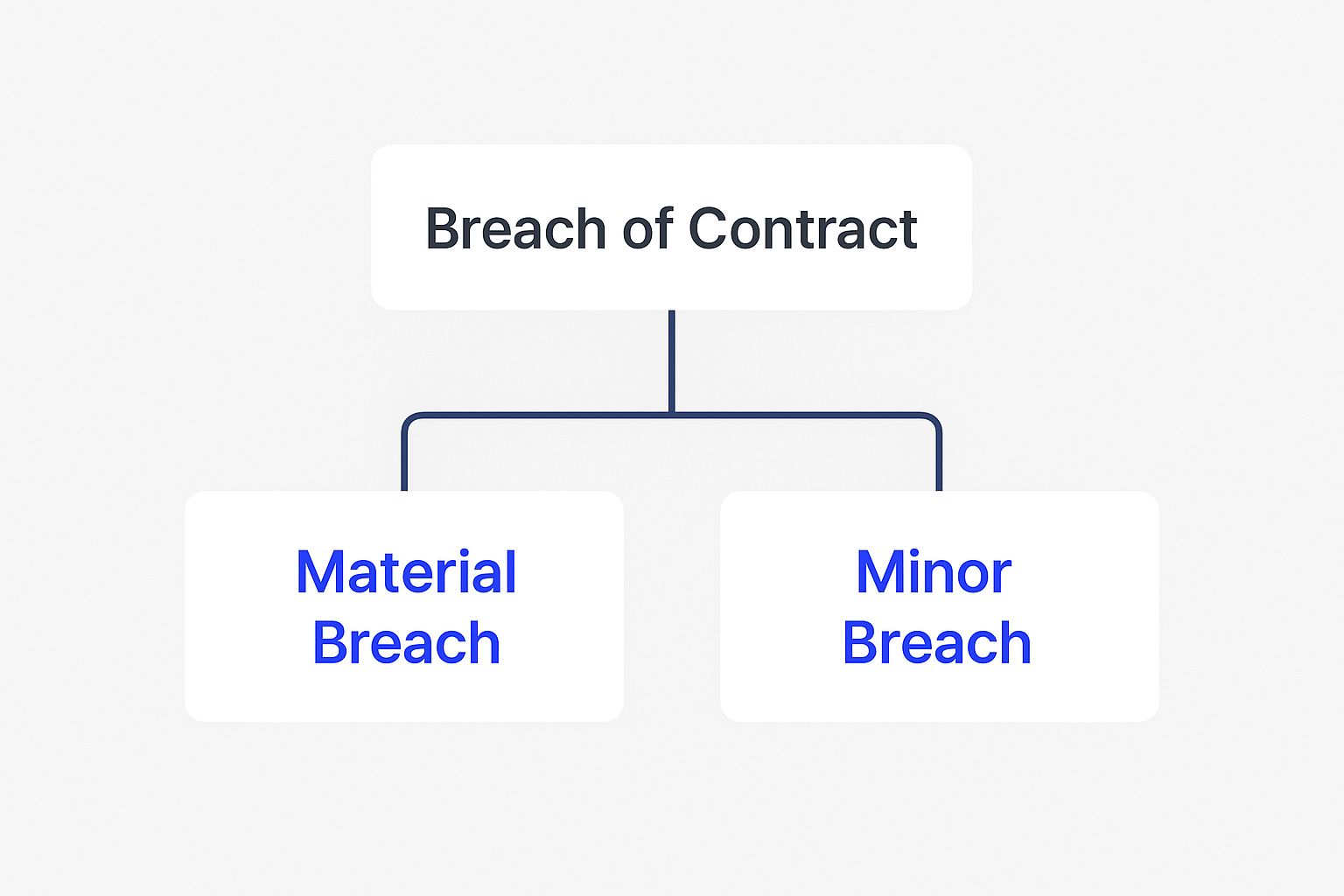
At its heart, a breach of contract is really just a broken promise in a legally binding agreement. When one party doesn't hold up their end of the bargain without a valid legal reason, they’ve breached the contract. This failure almost always causes some kind of harm to the other party.
What a Contract Breach Really Means

Think of it this way: a contract is like the blueprint for a custom-built house. It spells out every detail—the materials, the deadlines, the payment schedule. A breach of contract is what happens when the builder decides to swap out the specified high-quality materials for cheaper, weaker ones. Sure, a house still gets built, but it’s not the house you agreed to and paid for, and its value and safety are now compromised.
That failure to perform is the essence of a breach. But for a promise to be legally broken, it first has to be legally made. This means a valid, enforceable contract must have been in place to begin with.
The Foundation of a Breach
Before you can even talk about a breach, you have to prove a legitimate contract existed. A contract is more than just a signed piece of paper; it's a mutual agreement with specific elements that make it legally sound.
A breach happens when one party fails to fulfill their end of the bargain, causing tangible harm to the other. This simple concept is so fundamental to commerce that it forms a massive part of our legal system.
In fact, contract disputes are a huge part of the business world. Data from U.S. court systems shows that over the last two decades, disagreements over contracts have consistently made up 30-40% of all civil cases filed annually. It just goes to show how often these broken promises escalate into formal legal action. You can see more about the impact of contract breaches in legal and business settings.
To make it easier to see if a breach has actually happened, let's break down the core components you need to prove.
Quick Guide to Understanding a Breach
This table outlines the essential ingredients for a breach of contract claim. If any of these are missing, you likely don't have a case.
| Element | Simple Explanation | Why It Matters |
|---|---|---|
| Valid Contract | A legally enforceable agreement existed. | Without a valid contract, there are no obligations to break. |
| Performance | The wronged party fulfilled their duties. | You must show you held up your end of the deal. |
| Failure to Perform | The other party did not fulfill their duties. | This is the actual "breach" or broken promise. |
| Damages | The wronged party suffered a loss. | You must prove the breach caused you measurable harm. |
Having these four elements clearly established is the bedrock of any breach of contract claim. It’s the framework that courts use to determine whether a promise was truly broken and if the wronged party is entitled to a remedy.
The Four Main Types of Contract Breaches
When a contract gets broken, it’s not always a black-and-white situation. Just like a minor fender bender is handled differently than a car that’s been totaled, not all broken promises carry the same legal weight. Understanding what a breach of contract truly means involves recognizing these different levels of severity.
Legally speaking, breaches are usually sorted into four main categories. Each one describes how and when a party failed to deliver on their end of the bargain, which directly impacts the remedies available to the person who was wronged.
This diagram helps visualize how breaches are often categorized by how much they disrupt the core purpose of the contract.

As you can see, the first big question is whether the breach shatters the whole point of the agreement (a Material Breach) or is just a smaller hiccup (a Minor Breach).
Material Breach
A material breach is a major failure that cuts right to the heart of the contract. It's so significant that it completely undermines the purpose of the agreement, leaving the non-breaching party without the core benefit they were promised. This is the engine failure in our car analogy—the car just won't run.
For example, imagine you hire a catering company for your wedding, and they simply don't show up. That’s a textbook material breach. The entire reason for the contract—to have food at your wedding—is gone. You didn’t get what you paid for, and the failure is a total loss.
A material breach is a deal-breaker. It's a failure so substantial that it frees the harmed party from their own obligations and gives them the immediate right to sue for damages.
Minor Breach
A minor breach, sometimes called a partial or immaterial breach, is a less serious slip-up. A promise was technically broken, but it doesn’t torpedo the whole agreement. The non-breaching party still gets the main benefit they expected, even if one part wasn't executed perfectly. Think of this as getting your new car delivered with a small, barely noticeable scratch on the bumper; it's an issue, but the car still drives just fine.
Let's go back to the wedding example. What if the caterer delivered the wedding cake an hour later than planned? This would likely be a minor breach. You still got the cake, and the main purpose of that part of the contract was fulfilled. You might be able to get some compensation for the delay, but you can't just cancel the entire catering contract and refuse to pay for everything.
Anticipatory Repudiation
Sometimes, one party makes it clear they plan to breach the contract before their performance is even due. This is known as anticipatory repudiation. It’s a definite, unmistakable statement or action that shows they either can't or won't hold up their end of the deal.
Imagine a software developer signs a contract to deliver a custom app by December 1st. In October, they email the client to say they’ve taken on a bigger project and won't have time to finish the app. The client doesn't have to wait until December 1st to act. They can treat this as an immediate breach, find another developer, and sue the original one for any losses incurred.
Actual Breach
The most straightforward type is an actual breach. This is exactly what it sounds like: a party fails to perform their duties on the date they were supposed to. It’s a direct failure to deliver when performance was due.
For instance, a construction crew agrees to finish a kitchen remodel by May 30th. If May 30th comes and goes and the kitchen is still torn apart, an actual breach has occurred. The failure happened right on schedule, allowing the homeowner to seek remedies for the delay and any damages it caused.
Legal Consequences and Available Remedies

So, a promise has been broken. Knowing you're dealing with a breach of contract is just the first step. The real question is: what now? The legal system doesn't just point fingers; it offers a toolkit of remedies designed to make the wronged party whole again.
The main idea here isn't to punish the person who broke the contract. Instead, the goal is to put the non-breaching party back in the position they would have been in if everything had gone according to plan. Think of it as a financial do-over, trying to undo the damage caused by the breach.
And the financial stakes can be incredibly high. In the United States, commercial contract disputes have seen median damages awards climbing from $200,000 to over $1 million in major cases.
Common Legal Remedies
When things go south, courts have a few ways to set them right. Most of the time, the solution involves money, but occasionally, a court might order someone to perform a specific action.
Compensatory Damages: This is the most common fix. The party who broke the contract pays money to the other party to cover their direct losses. Let's say you paid a developer $50,000 for a custom app they never delivered. If you have to find a new developer who charges $65,000, you could sue for the $15,000 difference in compensatory damages.
Specific Performance: Sometimes, cash just doesn't cut it. This is a court order forcing the breaching party to do exactly what they promised. It’s a rare remedy, usually reserved for when the contract involves something truly unique, like a specific piece of real estate or a one-of-a-kind work of art.
Rescission and Restitution: This remedy basically hits the reset button and cancels the contract entirely. With rescission, the contract is declared void, and both parties are let off the hook for any future obligations. Then, restitution kicks in, requiring everyone to return any money or property they exchanged. It's like the whole deal never happened.
The core principle behind legal remedies is fairness. The law seeks to put the innocent party back in the financial or operational position they rightfully expected, ensuring the breach doesn't leave them with an unrecoverable loss.
Of course, the best way to deal with these messy outcomes is to avoid them altogether. Proactive and effective contract risk management is your best defense. By making sure all obligations and potential risks are crystal clear before anyone signs, you build a much stronger foundation and drastically reduce the chances of ever needing to seek these remedies in the first place.
How to Prove a Breach of Contract Occurred
Just feeling like a promise was broken isn’t enough to hold up in a legal dispute. When it comes to a breach of contract claim in court, proof is everything. You have to clearly show that a real, enforceable agreement was violated and that the violation caused you harm.
Successfully proving a breach means building your case around four essential pillars. Think of it like constructing an argument brick by brick—if even one is missing, the whole thing can fall apart. You need solid evidence for each one.
The Four Pillars of Proof
To build a strong case, you have to prove each of the following elements. This is the exact framework a court uses to decide if a breach actually happened and if you deserve a remedy for the damage.
- A Valid Contract Existed: First things first, you have to prove a legally binding agreement was actually in place. This is the foundation of your entire claim.
- You Did Your Part (Performance): You must show that you met all of your obligations under the contract. You held up your end of the deal.
- The Other Party Failed to Perform (The Breach): This is where you pinpoint exactly what the other party did—or didn't do—that went against the agreement.
- You Suffered a Loss (Damages): Finally, you have to demonstrate that their failure caused you a measurable, real-world loss.
A winning breach of contract claim isn't about fairness or feelings. It's about presenting a logical, evidence-backed argument that directly connects a broken promise to a tangible loss. Without that connection, your claim has no legal weight.
Gathering Your Evidence
To support these four pillars, you'll need to get your paperwork in order. The more organized and complete your evidence, the stronger your position will be.
Here's a quick checklist of what you'll need:
- The Contract Itself: The signed, written agreement is your most critical piece of evidence. For verbal contracts, this gets much trickier and usually relies on things like emails, text messages, and witness accounts.
- Proof of Your Performance: This includes invoices, payment receipts, project deliverables, or timesheets—anything that shows you fulfilled your side of the bargain.
- Evidence of the Breach: This could be anything from emails where the other party admits they can't deliver, to photos of shoddy work, or a timeline that clearly shows they missed deadlines.
- Proof of Financial Loss: You need to quantify how the breach cost you money. Bank statements, invoices from a replacement vendor, or expense reports are crucial here.
Of course, your best defense against future disputes is a rock-solid contract from the start. To sharpen your skills, check out our guide on how to negotiate contracts effectively and make sure your terms are clear and enforceable from day one.
Navigating Breach of Contract in the Real World

Legal definitions are a great starting point, but theory only gets you so far. The concept of a "breach of contract" really clicks when you see how it plays out in the real world. These scenarios connect the legal jargon to situations you might actually face, showing how a broken promise can have tangible, costly consequences.
Let's walk through a few stories from different industries. Each one puts a face on a specific type of breach, the clear harm it caused, and the logical steps taken to make things right.
The Marketing Agency and the Missing Leads
Imagine a small e-commerce business hires a marketing agency. The contract is crystal clear: the agency promises to deliver 200 qualified leads per month for a flat fee of $5,000. But for the first three months, they only manage an average of 50 low-quality leads, causing the business to completely miss its sales targets.
This is a classic material breach. The agency failed to deliver the core promise of the agreement—the very reason the business hired them. This failure deprived the business of the primary benefit it paid for. As a result, the e-commerce company would be justified in terminating the contract and suing for damages to recoup its fees and cover the lost revenue.
A contract's value lies in its promises. When the central promise is broken, it doesn't just bend the agreement—it shatters the foundation of the business relationship, giving the harmed party a clear path to seek remedies.
The Manufacturer and the Defective Parts
Picture a large automotive manufacturer with a contract for 10,000 custom-made bolts needed for its assembly line. The agreement specifies the bolts must meet a precise tensile strength. The first shipment arrives on time, but quality control tests reveal a serious problem: 20% of the bolts are defective and don't meet the required strength.
This situation presents a fork in the road. If the defective bolts bring production to a screeching halt, it could be considered a material breach. But if the manufacturer can still operate while waiting for replacements, it might just be a minor breach.
The logical remedy here is for the supplier to immediately replace the defective parts at their own cost. They may also need to compensate the manufacturer for any production delays they caused.
The Employee and the Non-Compete Violation
A senior software engineer leaves her job at a major tech firm. Her employment contract included a standard non-compete clause, preventing her from working for a direct competitor in the same city for one year. Just two months later, she accepts a lead engineering role at her former employer's biggest rival, located just down the street.
This is a straightforward actual breach of her employment agreement. The harm isn't just about a broken rule; it's the very real risk that trade secrets and confidential strategies could be exposed to a competitor.
The former employer could seek a court order (an injunction) to force the employee to quit her new job. If they can prove her new role caused them a financial loss, they could also sue for damages.
Of course. Here is the rewritten section, crafted to sound completely human-written and natural, following all the provided instructions and examples.
How to Proactively Prevent Contract Breaches
The best way to deal with a contract dispute is to stop it from ever happening. While you can't control what the other party does, you can absolutely build a rock-solid defense with a few proactive strategies. This means moving beyond a simple handshake and creating agreements designed to withstand pressure.
Think of a well-drafted contract like a pilot’s pre-flight checklist. It’s a systematic way to address potential problems before they turn into catastrophic failures mid-air. The whole point is to build a business relationship on a foundation of clarity, not risky assumptions.
Draft Clear and Unambiguous Agreements
Most contract disputes boil down to one thing: ambiguity. When terms are vague or left open to interpretation, each party can walk away with a completely different—and often conflicting—idea of their responsibilities. Your first line of defense is simply being precise.
- Define Everything: Clearly spell out key terms, deliverables, timelines, and payment schedules. Ditch the jargon and use plain language that anyone can understand.
- Set Realistic Expectations: Make sure everyone agrees on what a successful outcome looks like. Define performance metrics and quality standards so there’s no room for confusion down the line.
- Include Key Clauses: Smart contracts always include clauses for things like dispute resolution (think mediation or arbitration) and termination. These give you a clear off-ramp if the relationship goes south.
The most powerful tool for preventing a breach is a clear, detailed contract. It acts as a shared source of truth that aligns expectations and minimizes the risk of misunderstandings down the road.
This proactive approach is so important because once a breach happens, fixing it can be a painfully slow process. Research shows it takes, on average, over 12 months to resolve a breach-related lawsuit in major economies like the U.S. and UK. Catching issues early is your best bet to limit the damage. If you're curious about the numbers, you can find more insights on data breach statistics.
Establish Open Communication and Monitoring
A contract isn't a "set it and forget it" document. You have to keep the lines of communication open throughout the entire project. Regular check-ins can help you spot the warning signs—like missed milestones or evasive answers—long before they escalate into a full-blown breach.
If you sense trouble, don't wait. Sending a formal notice or just starting a conversation can often get the relationship back on track. For more complex agreements, using effective contract compliance management strategies and tools can help you automatically track obligations and deadlines, basically giving you an early warning system.
By building strong agreements from the start and staying vigilant, you empower yourself to manage risk and build more successful, lasting business relationships.
Got Questions About Contract Breaches? We've Got Answers.
Even with a solid grasp of what a breach of contract is, you’re bound to have some specific questions. It's a complex area, after all. This section cuts through the noise with straightforward answers to the things people most often ask, helping you feel more confident when you're in a tough spot.
Can Someone Breach a Verbal Agreement?
Absolutely. A handshake deal or a verbal agreement can be just as legally binding as a written one, which means it can also be breached. Many oral contracts hold up perfectly well in court.
The real challenge, though, isn't whether the agreement is valid—it's proving what the two of you actually agreed to. Without a written document, it comes down to what you can show. Success often depends on the evidence you can gather, like:
- Witnesses who were present and heard the terms being discussed.
- Emails, text messages, or other communications that refer to the agreement.
- Proof that you both started acting on the agreement, which shows you both believed a contract existed.
How Long Do I Have to File a Lawsuit for a Breach?
There's a deadline for that, and it's called the statute of limitations. This isn't a single, universal rule; it changes quite a bit depending on your state and the kind of contract you had.
For written contracts, you generally have a window of 3 to 10 years to file a lawsuit. But for oral agreements, the clock ticks much faster—often just 2 to 6 years. These deadlines are non-negotiable, so it's critical to check your local state laws the moment you suspect a breach has happened.
Do I have to go to court? Nope, and in many cases, you shouldn't. In fact, a lot of business contracts today require you to try mediation or arbitration first. These methods are usually less formal and cheaper than a full-blown lawsuit. Even if your contract doesn't have these clauses, you can always try to negotiate a settlement directly or through attorneys.
Navigating the ins and outs of a contract breach all comes down to understanding the language inside the document. Instead of losing hours trying to make sense of dense legal agreements, let Legal Document Simplifier handle it. Just upload your contract to get a clear, plain-language summary in minutes, complete with highlighted risks, deadlines, and obligations. Try Legal Document Simplifier today and start making smarter, faster decisions with total confidence.